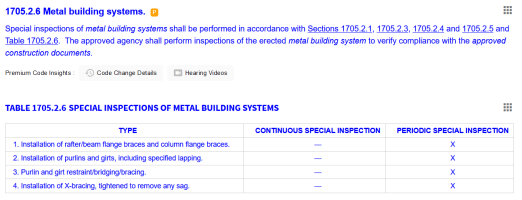Yankee Chronicler
REGISTERED
[I wasn't sure whether this belongs in Administrative, or under the Commercial Building Code heading. I think it's more pertinent to administration, but I won't be offended if it gets moved.]
One of the things we almost always get into arguments about with design professionals (usually structural engineers, in this case) is statements of special inspections. We often get applications for new buildings that don't have a statement of special inspections, then we get into an argument over whether or not it's required (yes, it is -- it says so right in the code), and then we go round and round about whether or not the SSI is filled out completely. Recently, we've seen an epidemic of pre-engineered metal buildings (PEMB) in town, and the statements of special inspection for tose are a nightmare because there are TWO engineers-of-record: the PEMB superstructure is designed, signed and sealed by an engineer in East Overshoe who is responsible for the metal building, but the foundations are designed by a local engineer who is only responsible for the footings and foundations. Properly speaking, there should be two separate statements of special inspections, unless the owner pays the local engineer to take on the role of special inspections coordinator for the superstructure in addition to the foundation.
When my state adopted the 2021 IBC in 2022, we added a section to chapter 17 that specifically described special inspections for PEMB. On one of the recent PEMB projects we asked for a SSI for the PEMB portion of the project. The owner submitted a letter from the PEMB company's engineer which stated that no special inspections were required -- and he included a special inspection table listing several special inspections tasks as "Not required." This left us in a urination contest with the owner, because we had to insist that it didn't matter what the PEMB engineer claimed, the code requires special inspections for PEMBs, so we needed a SSI that covers the specific inspection tasks called out in the code. Ultimately, the owner paid the foundation engineer to take on the special inspections role for the superstructure.
I'm mentioning this because special inspections for PEMBs has been added to the 2024 IBC, as section 1705.2.6. As states and jurisdictions begin to adopt the 2024 I-Codes, this is one of the changes to be aware of.

One of the things we almost always get into arguments about with design professionals (usually structural engineers, in this case) is statements of special inspections. We often get applications for new buildings that don't have a statement of special inspections, then we get into an argument over whether or not it's required (yes, it is -- it says so right in the code), and then we go round and round about whether or not the SSI is filled out completely. Recently, we've seen an epidemic of pre-engineered metal buildings (PEMB) in town, and the statements of special inspection for tose are a nightmare because there are TWO engineers-of-record: the PEMB superstructure is designed, signed and sealed by an engineer in East Overshoe who is responsible for the metal building, but the foundations are designed by a local engineer who is only responsible for the footings and foundations. Properly speaking, there should be two separate statements of special inspections, unless the owner pays the local engineer to take on the role of special inspections coordinator for the superstructure in addition to the foundation.
When my state adopted the 2021 IBC in 2022, we added a section to chapter 17 that specifically described special inspections for PEMB. On one of the recent PEMB projects we asked for a SSI for the PEMB portion of the project. The owner submitted a letter from the PEMB company's engineer which stated that no special inspections were required -- and he included a special inspection table listing several special inspections tasks as "Not required." This left us in a urination contest with the owner, because we had to insist that it didn't matter what the PEMB engineer claimed, the code requires special inspections for PEMBs, so we needed a SSI that covers the specific inspection tasks called out in the code. Ultimately, the owner paid the foundation engineer to take on the special inspections role for the superstructure.
I'm mentioning this because special inspections for PEMBs has been added to the 2024 IBC, as section 1705.2.6. As states and jurisdictions begin to adopt the 2024 I-Codes, this is one of the changes to be aware of.

